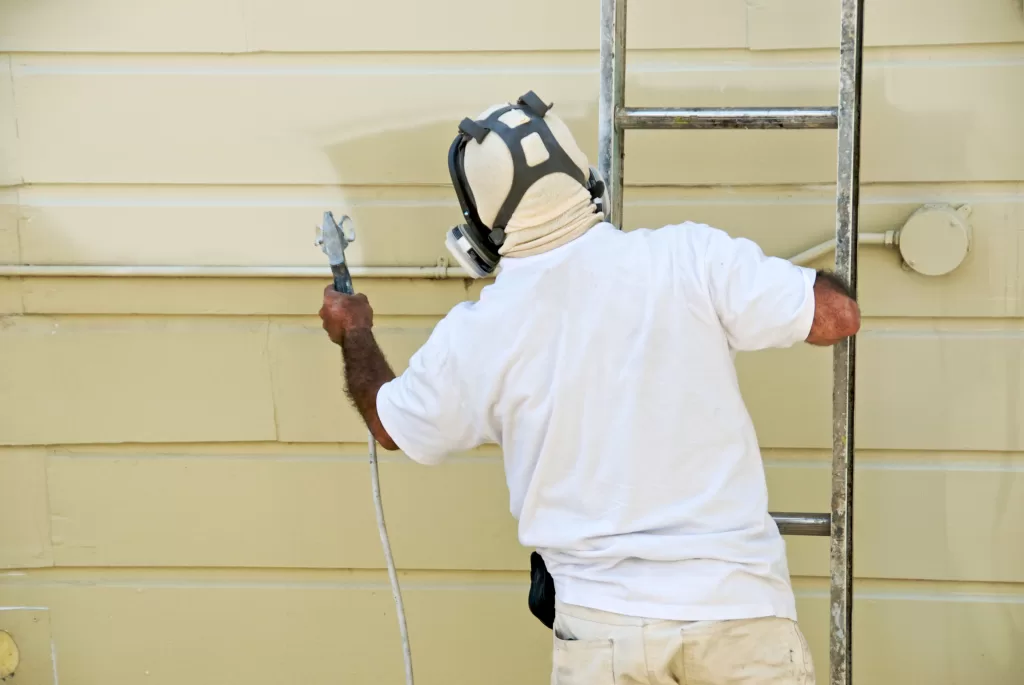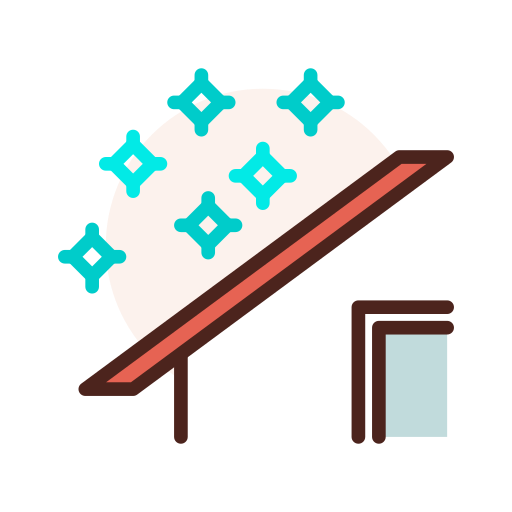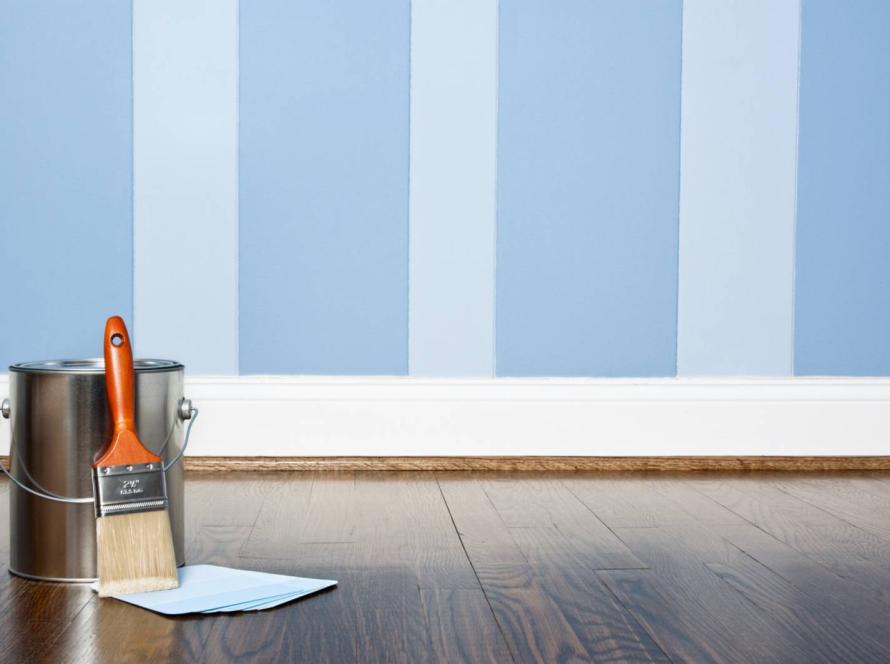Many interior paint jobs all look the same, and the result might look boring for your house. So, can you do anything to make sure your new layer of wall paint looks trendy and stylish? The simple answer is YES. And As it turns out, you can perfectly make a minimalist and modern wall painting all by yourself.
Here are some simple wall painting tips and ideas to make your house stand out without any trouble.
First, Choose the Right Paint
While choosing the right color for your walls is important, choosing the right paint quality is equally as important, if not more so. Choosing the right paint is especially important if you’re on a tight budget. You will need to do a lot of debating between cheap paints and expensive paints if you want to get the right result for your home.
For example, many people make the mistake of buying the cheapest can of paint available. This is almost always a bad idea for a variety of reasons. In particular, a cheap variety of paint isn’t likely to have as good coverage as a more expensive can of paint.
Instead of saving yourself money on paint, you’ll have to spend more on paint because you’ll need to paint over the first layer several times before you get the right result. This is not to mention that more labor is necessary to accomplish this, and you might need the help of a professional.
More than that, the paint might not spread as well on the wall. Instead, you might be able to see the streaks of when the paint was first applied and it might be impossible to get rid of those streaks.
Cheap and Expensive Paint
Even if you hire a professional to do the job for you, professional painters can only do so much when it comes to a can of cheap paint.
On the other hand, you shouldn’t necessarily buy the most expensive can of paint available. While more expensive paints tend to be of higher quality, the quality of the paint can only be so high. If you find that you are destroying your budget with the type of paint you’re choosing, it might be a better idea to choose a type of paint that has a relatively average price or a price that is slightly higher than average.
It’s hard to go wrong with mid-range paint. It should have good coverage and you shouldn’t have to apply too many layers to cover one wall. More than that, the paint should go on smoothly.
Most importantly, you won’t break the bank trying to buy a few cans of paint.
Wall Painting Tips to Consider

Before you start painting, you should understand a few important painting tips. Without knowing a little bit about wall painting, the paint job might not turn out as great as you wanted. For example, suppose that you have a large room that you need to paint, and you have several cans of the same paint that you plan on using.
To make things easier, it might be best to pour all of those cans of paint into one large container right away. That way, you won’t struggle to open up more cans of paint later on in your painting endeavors when you’re exhausted and your hands are dirty. Also, having a large vat of paint to dip your brushes and rollers in will be much more convenient than having to deal with many smaller paint cans.
This method is also useful if the cans of paint you have are very slightly different in color. Mixing them together will even out the color without actually changing the shade too much. Then, when you apply the paint to the wall, it will look very even and you won’t have to worry about mismatched walls.
Maintaining the Trim
When painting around the trim, you will want to be particularly careful. If you’re sloppy while painting around the trim, you will end up getting paint on the trim. The opposite can happen when you’re painting the trim and the paint ends up getting on the wall.
You can fix this by using some painter’s tape. The blue tape, for instance, won’t damage the wall in any way because it is not as strong as normal tape. Instead, it functions to make sure that the paint you’re using doesn’t go where it’s not supposed to.
The tape can also ensure that you get plenty of clean, straight edges for your paint job. However, this is only true if you wait for the paint to dry before taking the tape off. If you take the tape off before the paint is completely dry, you will find that the paint may drip down and ruin whatever is beneath it.
Once you have all of this figured out, you will be able to start following some simple beginner wall paint ideas in no time.
Try Using Stripes
You will find that many houses have walls that are plain and don’t have much personality. If you paint your walls a solid shade of white or blue, it might look nice for certain rooms, but for others, it might look far too empty and cold. This is especially true for large rooms with much space to fill.
In this case, you might want to experiment with some other colors and designs. Wall stripes have always been a popular alternative to a wall of solid color. For a striped wall, all you need is a couple of different paint colors and some patience.
In particular, you will need to ensure that the lines for the wall stripes are straight; otherwise, the result could look very sloppy. This is because stripes are very simplistic, and if there is any flaw in their design, anyone can notice it immediately. This may sound somewhat nerve-wracking, but you will find that painting stripes on your wall aren’t that big of a deal.
Stripes and Colors
First, you will want to make sure that you choose the right color combinations. While you can technically choose any combination of colors that you like, you don’t want your house to look like a funhouse. The best designs for striped walls tend to involve more neutral colors, such as soft greens, blues, whites, and grays.
Of course, there are some other designs that use other colors, such as white, yellow, and pink. The overall combination of colors shouldn’t be so striking that they give you a headache whenever you look at them. This is especially true for more calming environments such as the bedroom or kitchen.
Striped walls make for an affordable and easy design because they only require a few paint colors. You will also need plenty of painter’s tape and rulers to make sure that the stripes are straight and clean. Most wall stripes are verticle, although some houses also have horizontal stripes.
You can also choose to add stripes to only one wall of the room while the rest of the room is painted a solid color. This can give some great variety to the look of your room without making the space too overwhelming in appearance. This is not to mention that you can play around with thick and thin stripes.
Thick stripes are quite bold, while thin stripes are more interesting to look at. You can even add both stripes to one wall if you know how to design it well. Stripes are also great for rooms with low ceilings since the design can make the ceiling look taller than it is.
Choose Paint That Will Match Your Furniture

You will find that most wall colors don’t go with the furniture inside the room. For example, your simple bedroom wall might be all white while your furniture is brown or blue. While this can offer some appealing contrast to your room’s design, matching the color of the walls with the furniture can also be very visually appealing.
This is especially true since it is not a common thing to do. Of course, this idea is only feasible for those who have furniture that they don’t plan on getting rid of any time soon. For example, if you have a furniture set that you love, or perhaps an antique piece you’d never think of parting with, painting the walls to match your furniture could be a great idea.
This is in contrast to people who can’t stand their worn-down furniture set and want to get rid of it as soon as possible. This, of course, doesn’t mean that you should paint the entire room blue just because your chair is blue. Painting your walls in this way still requires some attention to detail.
Paying Attention to Detail
A room can easily become overwhelming to look at if it offers too many strong colors or a color that is too strong on its own. Instead, you may want to opt for a color-blocking technique instead of painting all the walls in solid colors. A color-blocking technique is exactly what it sounds like: it involves blocking certain areas of a wall with color.
This can give depth and intrigue to a wall that would otherwise be quite boring with just one color. For example, suppose you have some blue furniture and white furniture. By using the color-blocking technique, you can have certain parts of the room that are white and other parts that are blue.
This will make sure that neither color is too overwhelming when mixed with the color of the furniture. This technique can also make the paint job much more interesting since most walls in most houses use single, solid colors.
Paint Everything the Same Color Except for the Ceiling
As mentioned before, painting everything the same color can be overwhelming, but there are some cases where you might be able to get away with it. Painting everything the same color except for the ceiling might not work for every type of room. It especially wouldn’t be a good idea to paint every room in your house this way.
Instead, you should reserve this idea for a room that you want to add emphasis to or that you want to highlight. It can also be used for rooms that otherwise look pretty unartistic and dull. For example, suppose you have a kitchen that is not very appealing to look at most of the time.
The paint might be dull, the floor might be old, and everything in the room looks unappetizing. Of course, being in such a room will not get your creative juices flowing and it won’t help you get inspired when cooking.
On the other hand, painting the whole room one solid color except for the ceiling can change the room’s entire energy.
Immediately, it will be much sleeker than ever before. Because the same color blends into itself throughout the room, the room might even appear more spacious than it is.
For the best results, you will want to paint the floor the same color as the walls.
Pick the Right Color
If you paint the whole room a color that you don’t care for, you will find that you will start disliking the look of the room quite quickly. For example, if you want to paint your kitchen this way, try painting it light, vibrant colors such as blue, green, or pink.
Painting the entire room with one of these colors might ordinarily be overwhelming, but the trick is to leave the ceiling another color. White is usually the ideal color for the ceiling in this scenario. That’s because white perfectly contrasts against every other color you can think of.
Also, because white is a light shade, it will continue to contribute to the illusion that the room is bigger than it is in reality. This paint job can be somewhat time-consuming, but you will find that it can make your room much more visually appealing.
Use Geometric Shapes and Patterns
It’s hard to go wrong with geometric designs, no matter whether you’re painting on the wall, floor or ceiling. That’s because geometric designs go with virtually any other type of design as well as any color combination. Geometric designs make great use of the color-blocking technique.
You can use these designs as much or as little as possible. These designs can also transform your living space in many different ways. For example, suppose you have a large white living room devoid of personality.
You could try painting the living room another solid color, but would it change the problem? Probably not. On the other hand, if you add a geometric design to the white wall, you will find that the appearance of the room will change all at once.
Suppose you add a yellow zigzag design on the white wall and fill in half the wall with that color while the rest remains white. The whole room will immediately be filled with that vibrant yellow color. At the same time, the yellow won’t be too bright or overwhelming because it only takes up a portion of the wall.
The design of the zigzag is also unique and very beneficial. This is because the very shape of the zigzag insinuates motion. As a result, the room will have much more energy and personality than ever before.
Other Geometric Design Ideas
Of course, if you don’t like the idea of having a big zigzag in your room, you can always try another geometric design. For example, squares and rectangles can be useful for a large variety of rooms and cover the floors and walls. If you want to frame your couch, you can paint a large rectangle on the wall where your couch usually rests.
This will not only emphasize the couch but will provide a nice splash of color to the room. Triangles and circles have many uses, and you can put them just about anywhere. Small triangles grouped together can make for an interesting design in the kitchen or bathroom.
Large circles on the wall can make for the perfect places to hang picture frames or other pieces of home decor. The geometric designs could, in a way, act as their own pieces of art due to the color they provide to the room.
Paint Your Very Own Mural by Hand

If you want to unleash your artistic energy and talent, painting a mural by hand is a great way to start. Of course, a mural doesn’t have to be very realistic. In fact, many great wall murals are very abstract and mainly function to add color to a room.
However, when you’re painting your own house, you can design the mural to be however you want. If you’re hiring professionals who are skilled in creating murals, you can give them an idea of what you want the result to look like. However, remember that a mural will demand all the attention in a room.
For that reason, a mural may not be the best idea if you want the visual attention to be more spread out in a room or if you want the attention to be directed toward something else. On the other hand, adding a mural can be the perfect solution if you have a large room that is devoid of character.
Abstract Murals
An abstract mural is the easiest kind to create. You don’t have to worry at all about form or being exact. All you need to do is let the brush go wherever you feel like putting it.
Creating a mural this way is easy to mix colors and see what looks good on the wall. For example, if you’re starting with a big white wall, there are many types of murals and many types of colors that would look good. The size of the mural also makes a difference.
The larger the mural is, the more attention it will demand when you (or anyone else, for that matter) enter the room. On the other hand, if the mural is too small, it might look a little strange. The design can be one solid color or you might design it in an ombre fashion.
Whatever the case, you will want to make sure that the final colors of the mural harmonize with the rest of the room. Otherwise, the result might not look as good as you wanted it to.
It’s all a matter of taste

Compare Quotes from Top-rated Painting Contractors in your area.
When it comes to wall painting ideas, it’s all a matter of taste. there are so many designs and colors you can choose from. From stripes and geometric patterns to murals and beyond, there are endless ways in which you can spice up your home’s interior. If you’re not up to doing all the painting yourself, you can always rely on Top-Rated professional painters.
Millions of homeowners in the U.S. rely on Alpha Living to quickly find top-rated home painters in their area. Thanks to our large network of home professionals across the 50 states, we ensure our selected contractors match all your boxes.
Submit a few details here about the project you have in mind, and we’ll find the best local professionals for you within 24 hours!





Facebook
Comments